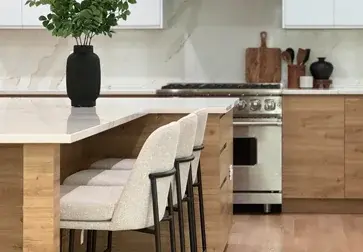The kitchen is the heart of the home, but it can also be a important funder to your household’s environmental footmark. From energy-guzzling applications to resource-intensive materials, traditional kitchen reconstructions can have a substantial impact. However, by embracing sustainable design values, you can create a lovely, functional, and eco-friendly kitchen that reduces its environmental impact.
Here are some key tips for making a maintainable kitchen design:
Prioritize Energy Efficiency:
- Energy-efficient applications: Look for applications with the Liveliness Star label. These appliances meet strict energy competence guidelines, consuming less energy and water than standard models. Consider introduction cooktops, which are more energy-efficient than traditional electric or gas ranges.
- LED light: Replace incandescent and fluorescent bulbs with LED lighting. LEDs use significantly less liveliness and have a much lengthier lifespan, reducing energy consumption and waste.
- Usual light: Maximize natural light by including larger windows or skylights. This reduces the need for artificial light during the day.
Minimize Waste:
- Plan carefully: Careful planning can help minimalize waste during the renovation process. Accurately amount your space and order materials accordingly to avoid excess.
- Reuse and repurpose: Consider reusing current cabinets, hardware, or appliances if they are in good condition. Repurposing materials can save capitals and add unique character to your kitchen.
- Recycle demolition debris: Properly dispose of and recycle destruction debris, such as wood, metal, and concrete.
Recover Indoor Air Quality:
- Good ventilation: Ensure passable ventilation with a good range hood to remove cooking fumes and contaminants from the air.
- Natural ventilation: Open windows and doors whenever likely to allow fresh air to circulate.
- Houseplants: Join plants to help purify the air and create a healthier indoor setting.
Reflect the Development Impact:
When choosing materials and crops, think about their entire growth, from industrial to removal. Opt for durable, long-lasting products that can be effortlessly repaired or recycled.
Work with Maintainable Professionals:
Consider working with a contractor or fashionable who concentrates in sustainable building practices. They can provide valuable guidance and help you make informed choices.
By joining these tips into your kitchen renovation project, you can create a beautiful, functional, and eco-friendly space that reduces its impact on the environment. A maintainable kitchen is not only good for the planet but also for your health and well-being. It’s an asset in a greener future and a healthier home.



